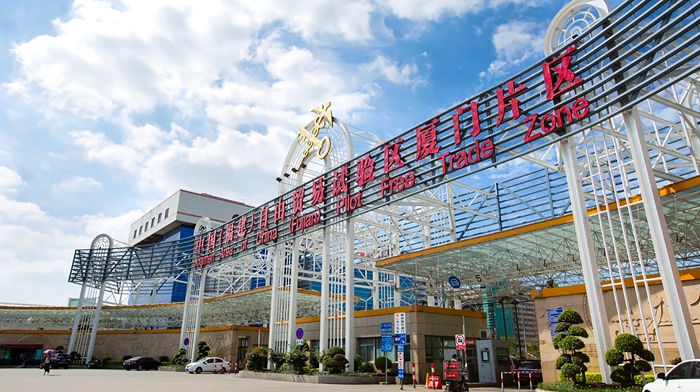
Xiamen Area of China (Fujian) Pilot Free Trade Zone [Photo provided to ftz.xm.gov.cn]
With its total area of 43.78 square kilometers, the Xiamen Area of China (Fujian) Pilot Free Trade Zone – or Xiamen Free Trade Zone, or XMFTZ for short – is located in the port city of the same name in East China's Fujian province.
Ever since it was launched – on April 21, 2015 – it has been working hard to promote high-level opening up.
Acting on the decisions and policies of the Communist Party of China Central Committee and the State Council – as well as those of the CPC Fujian Provincial Committee and the Fujian government – the area has issued an array of innovative initiatives that have boosted the high-quality development of the FTZ.
First: Pioneering institutional innovations with high quality
Over the past nine years, the Xiamen FTZ has introduced a total of 553 innovative measures, including 142 nationwide firsts. The State Council has issued documents to replicate and promote 30 pilot reform experiences across the country. Five exemplary cases, including the Xiamen International Trade Single Window, have been recognized as "best practice cases" for free trade zones nationwide. Additionally, 69 key policies critical to Xiamen's development have been approved.
Second: developing a world-class business environment
The Xiamen FTZ, in line with international standards, actively exploring and demonstrating the optimization of Xiamen's business environment. Xiamen's business environment ranking has risen 46 places since its inception, making it a benchmark city in the National Development and Reform Commission's "China Business Environment Report".
Third: Advancing high-level opening-up
The Xiamen FTZ launched China's first international train service originating from a free trade zone—the China-Europe (Xiamen) Railway Express. Currently, it is operating regularly on three main routes: Xiamen to Hamburg, to Almaty and to Moscow, connecting 12 countries and regions across Europe and Asia, linking 34 cities. This has established a new international logistics corridor crossing the Eurasian continent.
At the same time, it is implementing a foreign investment system for "pre-entry national treatment + negative list + record-filing management", enhancing the levels of modern governance and services. It is also introducing convenient measures such as the full electronic establishment of enterprises, attracting a large number of companies to settle in the Xiamen FTZ.
Fourth: Promoting trade facilitation through Xiamen International Trade Single Window
The Xiamen FTZ is boosting the level of construction of the Xiamen International Trade Single Window, in order to establish a top-tier port public information service ecosystem. It has developed an air cargo electronic freight platform and pioneered a "single window + air cargo logistics" model nationwide. Recognized by the General Administration of Customs of China (GACC) as one of the two pilot projects for air cargo logistics public information platforms, the pilot work has received full approval from the GACC and high praise from the Ministry of Commerce.
Fifth: Emphasizing legal primacy in construction of Legal District FTZ Pilot Zone
The Xiamen FTZ takes the lead in researching and planning the Maritime Silk Road Central Legal District FTZ Pilot Zone, creating the "Maritime Silk Road Central Legal Zone FTZ Service Hall" and the "Maritime Silk Road Central Legal Zone Platform", both in the online and offline platforms. Moreover, it is establishing a legal service hall to develop a legal service enterprise agglomeration area and to promote the aggregation of legal institutions in the FTZ.
Sixth: Cultivating new economy and momentum by focusing on key platforms
The Xiamen FTZ introduces three-year action plan, promoting the construction of 15 key platforms including aviation maintenance, financial leasing, imported wine, integrated circuits, and cross-border e-commerce. It has established a globally significant one-stop aviation maintenance base in China, becoming the fourth biggest aircraft financial leasing hub and the largest hub for second-hand aircraft financial leasing in the country. Xiamen has also emerged as the second biggest imported wine port, the largest edible birds nest deep processing base and the biggest lobster import port in China. These key platforms are said to serve as powerful engines that are driving high-quality development in Xiamen.